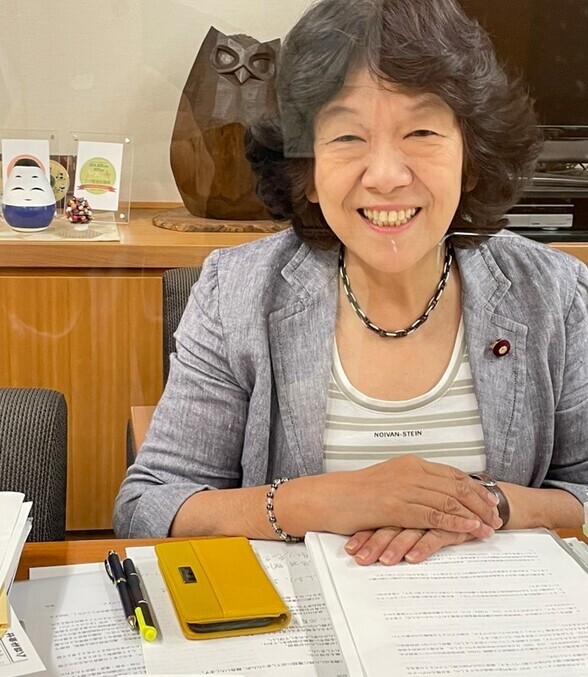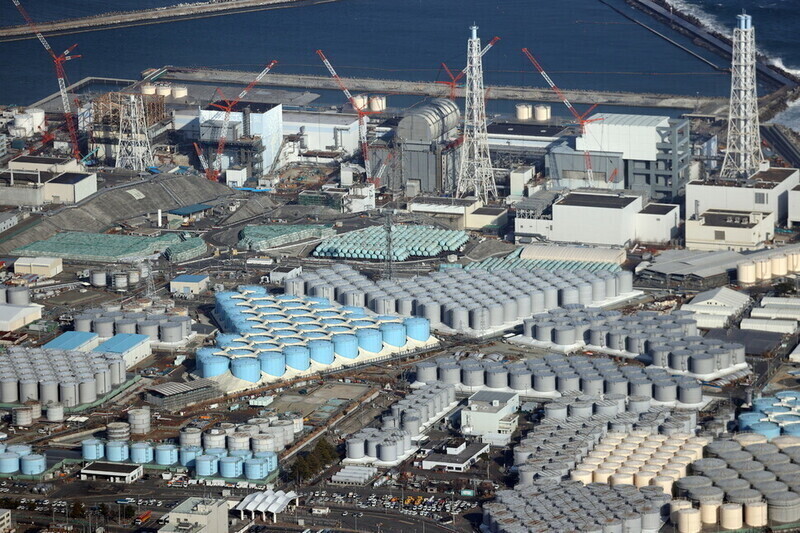hankyoreh
Links to other country sites 다른 나라 사이트 링크
[Interview] Japanese lawmaker proposes novel way of storing irradiated Fukushima water

Calling the sea the world’s “shared asset,” Tomoko Abe, 74, a member of Japan’s House of Representatives, has proposed a new alternative for the impending discharge of contaminated water from the Fukushima Daiichi nuclear power plant into the ocean: mixing Advanced Liquid Processing System (ALPS)-treated water with cement and sand to form a solid, then storing it.
The Hankyoreh sat down with Abe, who belongs to the Constitutional Democratic Party and is a member of a bipartisan group advocating for zero nuclear power and 100% renewable energy in Japan, for an interview at the House of Representatives in Tokyo\'s Chiyoda Ward on June 15.
During our interview, Abe was critical of the Japanese government and the International Atomic Energy Agency (IAEA), saying they aren’t conducting in-depth studies on the effects of long-term discharge on the marine environment.
She continues to use the phrase “ALPS-treated contaminated water” (hereafter written as contaminated water) because she believes that the water is still contaminated even after treatment.
Hankyoreh: The Japanese government plans to discharge the contaminated water into the sea later this summer once the IAEA issues a final report this month. What do you make of this plan?Tomoko Abe: This issue is not one that can be resolved by the Japanese government and the IAEA stating that the situation is fine. The sea is our shared asset. We need the understanding of the people who are concerned about the discharge and neighboring countries.
The IAEA General Safety Guide (GSG-8) states that “for planned exposure situations, justification is the process of determining whether a practice is, overall, beneficial, i.e. whether the expected benefits to individuals and to society from introducing or continuing the practice outweigh the harm (including radiation detriment) resulting from the practice.”
Since the discharge of contaminated water cannot be 100% safe, it has been strongly opposed by Japanese citizens, Korean fishermen, Pacific Island countries, and others. If there are no benefits and only risks, the discharge should be annulled. IAEA hasn’t reviewed this portion at all.
Hankyoreh: TEPCO is arguing that it’s reducing radiation to below legal thresholds with ALPS, and that diluting the unremoved tritium with sea water before dumping it makes it safe.Abe: The Fukushima Daiichi nuclear power plant is a nuclear reactor where an accident occurred [in March 2011], so there are all sorts of radioactive materials present in the water, including cesium and strontium. The government has not been doing any testing at all on the total quantities to see how much radioactive material it is dumping into the sea.
Even if the radioactive substances have been diluted to below the legal thresholds, we’re still talking about vast quantities of contaminated water, so we can’t ignore the total volumes. The number of nuclides that are measured before discharge has also been reduced from 64 to 30. If we’re going to assess the risks, we need to verify that as much as possible.
Hankyoreh: In connection with the water’s safety, there has also been some debate over the effectiveness of the ALPS system.Abe: There isn’t enough data to verify the effectiveness of ALPS. When they took samples to analyze the 64 nuclides, they only came from three tanks (K-4, J1-C, and J1-G) out of more than 1,000 where the contaminated water is stored.
An even bigger problem is that [an inquiry with TEPCO] found there to be no churning when the samples are taken [to mix them evenly]. The samples were collected from the upper part of the tank, where the radioactive material is less concentrated.
That means we can’t trust the data used to verify the effectiveness of ALPS. This is an act of deception.

Abe: It’s not too late. It is necessary to remove as much radioactive material as possible by running the water multiple times through ALPS, as TEPCO is doing now. Once the radioactive content has been lowered to below the threshold, it should be mixed with cement, sand, and other materials so it can be stored in solid form.
If you see what experts are saying, they talk about how that sort of concrete can be reused later on to make things like seawalls. It also obviates the need to keep storing them in the nuclear power plant tanks like we’re doing with the contaminated water.
Hankyoreh: Opinion surveys have shown 60% of the Japanese public supports the discharge of the contaminated water into the ocean.Abe: The fishers want to preserve the seas, and the opposition from them has been fierce. Polls say that 60% of people are supportive of the move, but not only has correct information not been provided to the people, but the overall mood regarding nuclear power in Japan is shifting. It feels as if we’re going back to before the 2011 earthquake (such as by allowing the use of nuclear plants beyond their 60-year lifespan). The nuclear meltdown is being underplayed, and it’s making people forget the lessons of that day.
Moreover, there’s no understanding of how we’re going to protect our marine environments, internationally speaking. I’m talking about more than just tritium — there’s a lack of thought about the contaminated water that’s coming out of the ruined nuclear reactor. Twelve years have passed since the meltdown, but fish that have been contaminated with cesium and other radioactivity continue to be caught. There’s endless biomagnification occurring.
We cannot discharge radioactive materials into the ocean. My hope is to discuss the issue of this contaminated water in a more transparent and democratic manner.
By Kim So-youn, Tokyo correspondent
Please direct questions or comments to [english@hani.co.kr]

Editorial・opinion
![[Column] Season 2 of special prosecutor probe may be coming to Korea soon [Column] Season 2 of special prosecutor probe may be coming to Korea soon](https://flexible.img.hani.co.kr/flexible/normal/500/300/imgdb/original/2024/0426/3317141030699447.jpg) [Column] Season 2 of special prosecutor probe may be coming to Korea soon
[Column] Season 2 of special prosecutor probe may be coming to Korea soon![[Column] Park Geun-hye déjà vu in Yoon Suk-yeol [Column] Park Geun-hye déjà vu in Yoon Suk-yeol](https://flexible.img.hani.co.kr/flexible/normal/500/300/imgdb/original/2024/0424/651713945113788.jpg) [Column] Park Geun-hye déjà vu in Yoon Suk-yeol
[Column] Park Geun-hye déjà vu in Yoon Suk-yeol- [Editorial] New weight of N. Korea’s nuclear threats makes dialogue all the more urgent
- [Guest essay] The real reason Korea’s new right wants to dub Rhee a founding father
- [Column] ‘Choson’: Is it time we start referring to N. Korea in its own terms?
- [Editorial] Japan’s rewriting of history with Korea has gone too far
- [Column] The president’s questionable capacity for dialogue
- [Column] Are chaebol firms just pizza pies for families to divvy up as they please?
- [Column] Has Korea, too, crossed the Rubicon on China?
- [Correspondent’s column] In Japan’s alliance with US, echoes of its past alliances with UK
Most viewed articles
- 1‘We must say no’: Seoul defense chief on Korean, USFK involvement in hypothetical Taiwan crisis
- 2Is Japan about to snatch control of Line messenger from Korea’s Naver?
- 3The dream K-drama boyfriend stealing hearts and screens in Japan
- 4Up-and-coming Indonesian group StarBe spills what it learned during K-pop training in Seoul
- 5S. Korea “monitoring developments” after report of secret Chinese police station in Seoul
- 6Division commander ordered troops to enter raging flood waters before Marine died, survivor says
- 7[Column] ‘Choson’: Is it time we start referring to N. Korea in its own terms?
- 8[Editorial] New weight of N. Korea’s nuclear threats makes dialogue all the more urgent
- 9Will NewJeans end up collateral damage in internal feud at K-pop juggernaut Hybe?
- 10‘Weddingflation’ breaks the bank for Korean couples-to-be